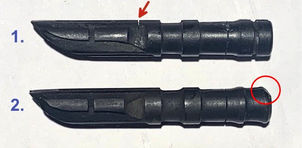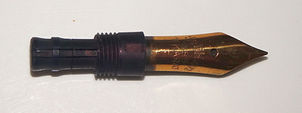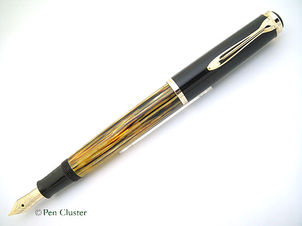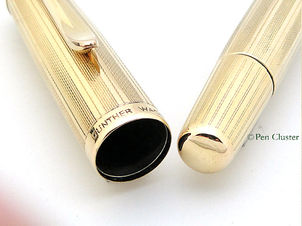top of page
Pelikan 400 (ca.1952)
In August, 1950, model 400 reverted to the traditional screw-in fit nib unit (Pelikan Schreibgeräte). The early type feed had slit in the back-end no more (click). The socket was equipped with two notches to apply the special wrench, with which the nib unit was removable easily and safely from the grip section⁽²⁾. The feed and piston seal were also improved over time. Around 1952 (or 1953), the feed was redesigned. The late type feed (I call the redesigned feed so) had a main ink/air channel⁽³⁾, an additional air channel on its ventral side, and a circumferential groove at its tail⁽⁴⁾. Thus, the feed now had technically upgraded ink/air channels, contributing to stable ink flow, ink availability, and leak-proof. Late type feeds were passed on to model 400N and 400NN (Pelikan’s Perch). As for the piston seals, there were three types of seals that were used for model 400 (and post war 100N). Disk-shaped transparent nylon seal was newly developed and introduced when model 400 was launched in 1950 (Pelikan Schreibgeräte). This seal was also used for model 100N. Black elastomer seal was still in production for model 100N when model 400 was introduced (Pelikan-collectibles). There are several reports of this seal being installed on model 400 (Pelikan’s Perch). It is assumed that this seal was used for (or diverted to) model 400⁽⁵⁾, although it is not known how much or how long. As disk-shaped transparent nylon seal seemed to be not robust enough in some cases, wide transparent nylon seal was introduced on November 27, 1953 (Pelikan Schreibgeräte), replacing disk-shaped transparent nylon seal. This new seal was sufficiently robust and reliable⁽⁶⁾, and used for the subsequent models.
Subsequent events regarding model 400 can be summarized as follows.
-
From June 15, 1951, colored cap tops were made available (Pelikan Schreibgeräte). The colored cap helped to know the color of ink used (even unusual colors such as purple and white were known) (Pelikan-collectibles).
-
From April 1952, the nib specification was engraved on the nib (Pelikan-collectibles)⁽⁷⁾.
-
From mid-1954, the cap ring was engraved with "Pelikan 400" or "Pelikan 400 Germany" (Pelikan’s Perch)⁽⁷⁾.
-
In December 1954, so-called fir tree nib with stylized pelican logo was introduced (Pelikan catalog No.90 (1955))⁽⁷⁾.
-
On May 23, 1955, model 455, the matching ballpoint pen was introduced.
-
At some timepoint, the cap tube end was reinforced with a metal tube (refer to Pelikan 400 transparent demonstrator).
Like model 100/100N, model 400 series were exported. The most famous export models were "Pelican" model and 18 carat gold nib model, but there were also other export pens with "EXPORT" engraving on the barrel.
As for (semi)luxury models, model 600 with solid 14 carat gold (cap top overlay, cap tube overlay, crown, clip, and turning knob overlay) was introduced on September 18, 1950. Model 700 all in solid 14 carat gold (cap top overlay, cap tube overlay, crown, clip, sleeve, and turning knob overlay) was introduced in February 1951. Model 600 was similar in appearance to model 500, but could be distinguished from model 500 by its hallmark (585). However, in response to requests/complaints from the consumers, the cap of model 600 was engraved with "Günther Wagner Germany 14c-585 Pelikan" from June 20, 1952. Furthermore, model 600 was fitted with gold cap top from September 23, 1952. Accordingly, matching pencil 650 was fitted with gold push button (Pelikan Schreibgeräte). Model 520 all in gold filled (cap tube, crown, clip, sleeve, and turning knob) was introduced on June 13, 1955 (Pelikan Schreibgeräte). Model 700 was similar in appearance to model 520, but could be distinguished from model 520 by hallmarks (14c-585) in every part.
In 1956, model 400 was discontinued, and replaced by model 400N⁽⁸⁾. Although it was only in production for 6 years, model 400 achieved remarkable progress, both technically and aesthetically.
Note;⁽¹⁾According to @stoen, the redesigned feed of 100N and the early type feeds of model 400 and 140 were most likely machined from the same four-fin template, then the back-end would have been trimmed and fine-adjusted for them (please see Pelikan 100N (ca.1950) Fig.11).
⁽²⁾The old plier for model 100(N) could damage the nib. However, the new wrench raised patent disputes with Montblanc (Pelikan Schreibgeräte, Pelikan’s Perch), as Montblanc already had a similar socket wrench, and filed a patent protection. At the same time, Günter Wagner was also filing a complaint against Montblanc for patent infringement as for the telescopic mechanism and screw-in nib unit in Monte Rosa. Finally, Günter Wagner and Montblanc came to an agreement that Montblanc would allow Günter Wagner to use the new wrench without paying royalties to Montblanc, and that Günter Wagner in turn would drop patent infringement complaint against Montblanc. So, the patents concerning these mechanisms could be used by both companies without patent infringement.
⁽³⁾Main ink/air channel consisted of one wide groove in the center and two side grooves. Ink goes out through two side grooves, while air comes from a nib vent hole through one central groove into ink reservoir. Two types of feeds are known, of which, feed (1) is thought to be produced earlier. According to @stoen, "lateral slit of feed (1) (red arrow) should have served both as additional air intake as well as pressure equalizer, optimizing the ink flow. Feed (2) must have obtained similar result with the re-designed back end. Also, the reintroduced slanted back end of feed (2) (red circle) probably improved performance at low ink levels. Therefore, feed (2) was logical evolution of (1), backed with enormous market feedback, and also a bit simpler to make." For the subsequent models (400N, 400NN), both feed (1) and feed (2) were used. Nowadays, many modern Pelikan feeds have partially slanted backsides. So, feed (2) may be one of the prototypes of modern Pelikan feeds.
⁽⁴⁾This groove seemed to guide ink from the lowest part of the reservoir to the dorsal ink channel when the ink level was low.
⁽⁵⁾As the material was not durable and tended to shrink, many black elastomer seal were replaced with later more durable seals (@stoen). Now, there are so few surviving black elastomer seals in 400 pens.
⁽⁶⁾Therefore, we often see vintage Pelikan pens with old seals replaced with this type of seal.
⁽⁷⁾You can tell if a model 400 was made before 1952 or after 1954 by looking at the cap and nib. My pen may be dated from 1952 to mid-1954.
⁽⁸⁾In fact, model 400N was introduced in December 1955. The August 1956 retail brochure listed all three models (model 400, 400N, 400NN) (Pelikan Schreibgeräte).
Feeds of model 400
Piston seals of model 400
Pelikan 400 (ca.1952)
My collection.
Export model
400 box (late version?)
My collection.

Friction fit nib unit of M400 (ca.1982)
My collection.

bottom of page



























